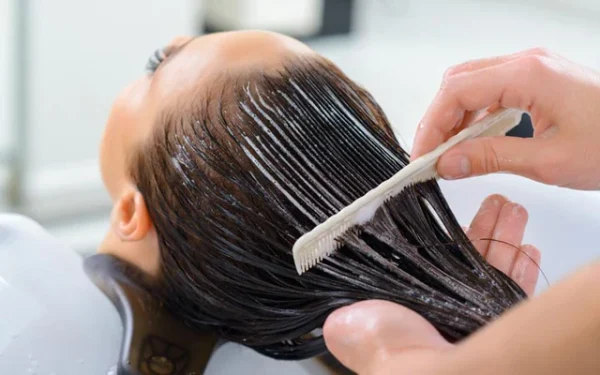
Many people have been turning to keratin treatments as a way to get smooth, frizz-free hair. These treatments have become very popular among people who want to transform their unruly hair into smooth and manageable strands. However, with all the talk about keratin treatments, it’s natural to have questions about their safety, how well they work, and what they actually do to your hair. This blogpost answers the question is keratin treatment good for hair? Read on, lets help you determine if this hair-smoothing option is suitable for you.
Is Keratin Treatment Good for Hair?
Keratin is a protein that is naturally present in hair, skin, and nails. It is important for keeping the hair shaft strong and maintaining its structure. During a keratin treatment, a liquid keratin solution is usually applied to the hair. This solution is then sealed in by using heat from a flat iron. The purpose of this process is to make the hair cuticle smoother, decrease frizz, and make the hair shinier. As a result, the hair becomes easier to manage and looks sleeker.
Pros of Keratin Treatment
Smoother, Frizz-Free Hair: One of the main advantages of keratin treatments is their capacity to create sleek, silky hair from frizzy, unmanageable locks. By sealing the cuticle of the hair, the treatment lessens frizz and flyaways and leaves the hair feeling and looking velvety soft.
Long-Lasting effects: Keratin treatments have the potential to produce semi-permanent effects that persist for several weeks to months, in contrast to some other hair treatments that gradually wash away. The benefits of a keratin treatment can last through several washings and style sessions with the right upkeep.
Faster Style Time: Hair that has had keratin treatment is typically easier to manage and style, taking less time and effort to get the desired appearance. Whether you like your hair straight, curly, or wavy, getting a keratin treatment will make styling your hair easier and more effective.
Better Hair Health: Keratin treatments have advantages for the appearance of hair as well as for the general health of the hair. Keratin treatments help strengthen the hair shaft and shield the hair from environmental damage, which over time can result in healthier, more robust hair.
Cons of Keratin Treatment
Formaldehyde Exposure: To attach keratin to the hair shaft, many traditional keratin treatments include formaldehyde or formaldehyde-releasing chemicals. In addition to being a proven carcinogen, formaldehyde can irritate some people or trigger allergic reactions. Selecting a keratin treatment that is formaldehyde-free or has a low formaldehyde content is crucial to reducing exposure.
Cost: If you choose to have salon treatments done by qualified stylists, keratin treatments may be pricey. The price of maintenance items can also raise the total cost. Examples of these goods are sulfate-free shampoos and conditioners that are advised to be used following a keratin treatment.
Temporary Nature: Although semi-permanent results can be achieved with keratin treatments, they are not a permanent solution for smoothing or straightening hair. The treatment’s benefits will progressively wear off as the treated hair grows out; touch-ups every few months are therefore necessary to keep the intended look.
Potential Damage: Keratin treatments have the potential to cause damage to certain people’s hair, especially if they are done incorrectly or if their hair is overprocessed. To reduce the danger of damage, it is essential to have a full hair inspection and talk with a skilled stylist prior to receiving a keratin treatment.
Frequently Asked Questions About Keratin Treatment for Hair
1. What exactly is a keratin treatment, and how does it work?
A keratin treatment is a semi-permanent hair straightening and smoothing treatment that typically involves applying a keratin-based solution to the hair, which is then sealed in using heat from a flat iron. The treatment helps to smooth the hair cuticle, reduce frizz, and enhance shine by replenishing lost keratin protein in the hair shaft.
2. Is keratin treatment suitable for all hair types?
Keratin treatments are generally safe for most hair types, including curly, wavy, frizzy, and chemically treated hair. However, keratin treatment may weaken the hair shaft in severely damaged or overprocessed hair.
3. How long do the results of a keratin treatment last?
The longevity of keratin treatment results can vary depending on factors such as hair type, texture, and maintenance routine. On average, keratin treatments last four to six weeks for standard treatments and several months for long-lasting formulations. Regular touch-ups and proper maintenance can help prolong the effects of the treatment.
4. Are keratin treatments safe for use on chemically treated or colored hair?
Yes, keratin treatments are generally safe for use on chemically treated or colored hair. Keratin treatments replace protein and smooth the hair cuticle, repairing and protecting chemically treated hair. Keratin treatments should be done at least two weeks after coloring or chemically treating hair to avoid harm.
5. Can I wash my hair after getting a keratin treatment?
Most hairdressers recommend waiting 72 hours (three days) before washing hair after keratin treatment to fully connect. After the initial waiting period, sulfate-free shampoos and conditioners are necessary to preserve treatment benefits and lifespan.
6. Are there any potential side effects or risks associated with keratin treatments?
A competent professional can execute keratin treatments safely, but there are dangers and negative effects. Some individuals may experience scalp irritation, allergic reactions, or sensitivity to the chemicals used in the treatment. Additionally, traditional keratin treatments that use formaldehyde or formaldehyde-releasing chemicals may cause respiratory irritation or allergic reactions, especially in asthmatics.
7. Can I style my hair as usual after getting a keratin treatment?
Yes, one of the benefits of keratin treatments is that they make hair more manageable and easier to style. After a keratin treatment, you can style your hair straight, wavy, or curly. Hot styling tools can damage hair and limit treatment life, so avoid them.
Conclusion
While keratin treatments provide a short-term fix for frizz-free, silky hair, there are dangers and disadvantages that should be carefully evaluated. It’s important to read up on the substances used in keratin treatments, talk to your stylist about any concerns you may have, and balance the benefits and drawbacks given your particular hair type and way of life before getting one. While some people find that keratin treatments produce amazing results, others might choose to look into other ways to achieve healthy, attractive hair without using harsh chemicals or heat styling techniques. In the end, choosing to get a keratin treatment should be carefully considered, with an emphasis on giving general health and hair health top priority.

Leave a Reply